 Design Is the Problem: The Future of Design Must be SustainableNathan Shedroff Design Is the Problem: The Future of Design Must be SustainableNathan Shedroff Product design can have a tremendous impact on the world in terms of usability, waste, and resources. In Design Is the Problem, Nathan Shedroff examines how the endemic culture of design often creates unsustainable solutions, and shows how to ensure that design processes lead to more sustainable products and services.
TESTIMONIALS
"If a sustainable world is to be less about stuff, and more about people, what should designers design? Nathan Shedroff challenges designers to focus on what the experience of a sustainable world can be like. I hope every designer will read this book: they ll be inspired to learn that even as they stop creating stuff, there s still a lot of work for them to do."
John Thackara, creator of the Door of Perception conference, author of In The Bubble
"Nathan Shedroff has demonstrated a new discipline as a design deviant. He deviates from the norm of cause (perceived need) and effect (delightful fetish) to question whether we can design to fulfill experiences or true needs by crafting not what is simply less, but something different. This is an opening volley for the next new economy."
Ric Grefe, Executive Director, AIGA
"Design is the Problem illustrates that, when done intentionally and thoughtfully, design can be the solution to our most pressing social and environmental challenges. The book is a comprehensive primer for anyone interested in redesigning not just products, but the way we do business, the way we address problems, and the way we envision and forge our future."
Simran Preeti Sethi, co-host/writer of Sundance Channel s "The Green" and contributing author to Ethical Markets: Growing the Green Economy  Everything Bad Is Good for You: How Today's Popular Culture Is Actually Making Us SmarterSteven Johnson Everything Bad Is Good for You: How Today's Popular Culture Is Actually Making Us SmarterSteven Johnson From the author of the New York Times bestseller Mind Wide Open comes a groundbreaking assessment of popular culture as it's never been considered before: through the lens of intelligence.
The $10 billion video gaming industry is now the second-largest segment of the entertainment industry in the United States, outstripping film and far surpassing books. Reality television shows featuring silicone-stuffed CEO wannabes and bug-eating adrenaline junkies dominate the ratings. But prominent social and cultural critic Steven Johnson argues that our popular culture has never been smarter.
Drawing from fields as diverse as neuroscience, economics, and literary theory, Johnson argues that the junk culture we're so eager to dismiss is in fact making us more intelligent. A video game will never be a book, Johnson acknowledges, nor should it aspire to be-and, in fact, video games, from Tetris to The Sims to Grand Theft Auto, have been shown to raise IQ scores and develop cognitive abilities that can't be learned from books. Likewise, successful television, when examined closely and taken seriously, reveals surprising narrative sophistication and intellectual demands.
Startling, provocative, and endlessly engaging, Everything Bad Is Good for You is a hopeful and spirited account of contemporary culture. Elegantly and convincingly, Johnson demonstrates that our culture is not declining but changing-in exciting and stimulating ways we'd do well to understand. You will never regard the glow of the video game or television screen the same way again. 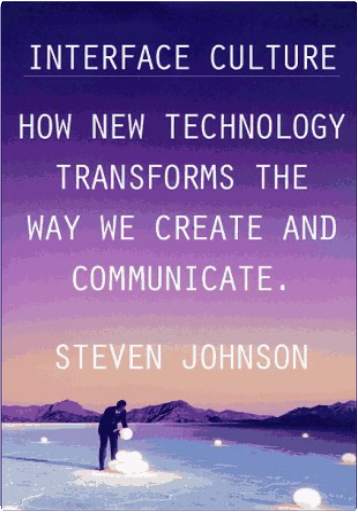 Interface Culture: How the Digital Medium—from Windows to the Web—Changes the way We Write, SpeakStephen Johnson Interface Culture: How the Digital Medium—from Windows to the Web—Changes the way We Write, SpeakStephen Johnson "As our machines are increasingly jacked into global networks of information, it becomes more and more difficult to imagine the dataspace at our fingertips, to picture all that complexity in our mind's eye . . . Representing all that information is going to require a new visual language, as complex and meaningful as the great metropolitan narratives of the 19th-century novel."—from Interface Culture
In this hip, erudite manifesto, Steven Johnson—one of the most influential people in cyberspace, according to Newsweek bridges the gap that yawns between technology and the arts. Drawing on his own expertise in the humanities and on the Web, he not only demonstrates how interfaces—those buttons, graphics and words on the screen through which we control information—influence our daily lives, but also tracks their roots back to Victorian novels, early cinema and even medieval urban planning. The result is a lush cultural and historical tableau in which today's interfaces take their rightful place in the lineage of artistic innovation.
With Interface Culture, Johnson brilliantly charts the vital role interface design plays in modern society. Just as the great novels of Melville, Dickens and Zola explain a rapidly industralizing society to itself, he argues, web sites, Microsoft Bob, flying toasters and the landscapes of video games tell the digital society how to imagine itself and how to get around in cyberspace's unfamiliar realm.
The role once played by novelists is now fulfilled by the interface designer, who has bridged the gap between technology and everyday life by providing a conceptual framework for the vast amounts of information and computation that surround us.
Johnson boldly explores the past—a terrain few tech thinkers have dared enter, and one that throws dazzling light on the modern interface's roots. From the great cathedrals of the Middle Ages to the rise of perspective drawing in the Renaissance, from Enlightenment satire to the golden age of television, Interface Culture uses a wealth of venerable "interface innovation" to place newfangled creations like Windows 95 and the Web in a rich historical context.
Controversial, clear-sighted and challenging, Interface Culture also looks at the future—from what PC screens will look like in 10 years to how new interfaces will alter the style of our conversation, prose and thoughts. With a distinctively accessible style, Interface Culture brings new intellectual depth to the vital discussion of how technology has transformed society, and is sure to provoke wide debate in both literary and technological circles.  The Invention of AirSteven Johnson The Invention of AirSteven Johnson Bestselling author Steven Johnson recounts—in dazzling, multidisciplinary fashion—the story of the brilliant man who embodied the relationship between science, religion, and politics for America’s Founding Fathers.
The Invention of Air is a book of world-changing ideas wrapped around a compelling narrative, a story of genius and violence and friendship in the midst of sweeping historical change that provokes us to recast our understanding of the Founding Fathers.
It is the story of Joseph Priestley—scientist and theologian, protégé of Benjamin Franklin, friend of Thomas Jefferson—an eighteenth-century radical thinker who played pivotal roles in the invention of ecosystem science, the discovery of oxygen, the founding of the Unitarian Church, and the intellectual development of the United States. And it is a story that only Steven Johnson, acclaimed juggler of disciplines and provocative ideas, can do justice to.
In the 1780s, Priestley had established himself in his native England as a brilliant scientist, a prominent minister, and an outspoken advocate of the American Revolution, who had sustained long correspondences with Franklin, Jefferson, and John Adams. Ultimately, his radicalism made his life politically uncomfortable, and he fled to the nascent United States. Here, he was able to build conceptual bridges linking the scientific, political, and religious impulses that governed his life. And through his close relationships with the Founding Fathers—Jefferson credited Priestley as the man who prevented him from abandoning Christianity—he exerted profound if little-known influence on the shape and course of our history.
As in his last bestselling work, The Ghost Map, Steven Johnson here uses a dramatic historical story to explore themes that have long engaged him: innovation and the way new ideas emerge and spread, and the environments that foster these breakthroughs. And as he did in Everything Bad Is Good for You, Johnson upsets some fundamental assumptions about the world we live in—namely, what it means when we invoke the Founding Fathers—and replaces them with a clear-eyed, eloquent assessment of where we stand today. 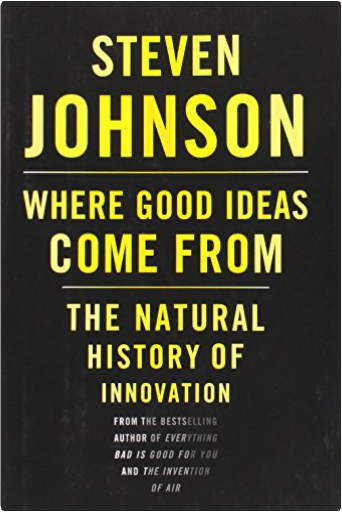 Where Good Ideas Come From: The Natural History of InnovationSteven Johnson Where Good Ideas Come From: The Natural History of InnovationSteven Johnson One of our most innovative, popular thinkers takes on-in exhilarating style-one of our key questions: Where do good ideas come from?
With Where Good Ideas Come From, Steven Johnson pairs the insight of his bestselling Everything Bad Is Good for You and the dazzling erudition of The Ghost Map and The Invention of Air to address an urgent and universal question: What sparks the flash of brilliance? How does groundbreaking innovation happen? Answering in his infectious, culturally omnivorous style, using his fluency in fields from neurobiology to popular culture, Johnson provides the complete, exciting, and encouraging story of how we generate the ideas that push our careers, our lives, our society, and our culture forward.
Beginning with Charles Darwin's first encounter with the teeming ecosystem of the coral reef and drawing connections to the intellectual hyperproductivity of modern megacities and to the instant success of YouTube, Johnson shows us that the question we need to ask is, What kind of environment fosters the development of good ideas? His answers are never less than revelatory, convincing, and inspiring as Johnson identifies the seven key principles to the genesis of such ideas, and traces them across time and disciplines.
Most exhilarating is Johnson's conclusion that with today's tools and environment, radical innovation is extraordinarily accessible to those who know how to cultivate it. Where Good Ideas Come From is essential reading for anyone who wants to know how to come up with tomorrow's great ideas. 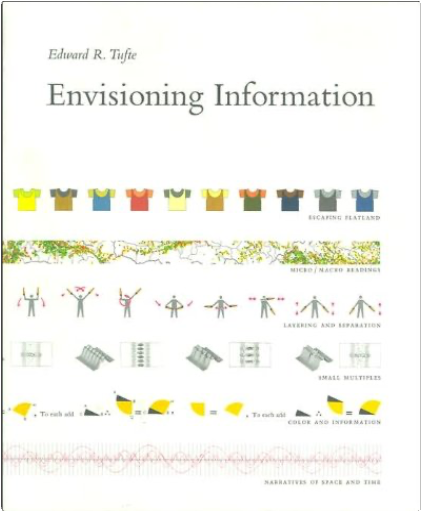 Envisioning InformationEdward R. Tufte Envisioning InformationEdward R. Tufte This book celebrates escapes from the flatlands of both paper and computer screen, showing superb displays of high-dimensional complex data. The most design-oriented of Edward Tufte's books, Envisioning Information shows maps, charts, scientific presentations, diagrams, computer interfaces, statistical graphics and tables, stereo photographs, guidebooks, courtroom exhibits, timetables, use of color, a pop-up, and many other wonderful displays of information. The book provides practical advice about how to explain complex material by visual means, with extraordinary examples to illustrate the fundamental principles of information displays. Topics include escaping flatland, color and information, micro/macro designs, layering and separation, small multiples, and narratives. Winner of 17 awards for design and content. 400 illustrations with exquisite 6- to 12-color printing throughout. Highest quality design and production.  Beautiful EvidenceEdward R. Tufte Beautiful EvidenceEdward R. Tufte Science and art have in common intense seeing, the wide-eyed observing that generates visual information. Beautiful Evidence is about how seeing turns into showing, how data and evidence turn into explanation. The book identifies excellent and effective methods for showing nearly every kind of information, suggests many new designs (including sparklines), and provides analytical tools for assessing the credibility of evidence presentations (which are seen from both sides: how to produce and how to consume presentations). For alert consumers of presentations, there are chapters on diagnosing evidence corruption and PowerPoint pitches. Beautiful Evidence concludes with 2 chapters that leave the world of pixel and paper flatland representations - and move onto seeing and thinking in space land, the real-land of three-space and time.  Why Architecture MattersPaul Goldberger Why Architecture MattersPaul Goldberger Why Architecture Matters is not a work of architectural history or a guide to the styles or an architectural dictionary, though it contains elements of all three. The purpose of Why Architecture Matters is to “come to grips with how things feel to us when we stand before them, with how architecture affects us emotionally as well as intellectually”—with its impact on our lives. “Architecture begins to matter,” writes Paul Goldberger, “when it brings delight and sadness and perplexity and awe along with a roof over our heads.” He shows us how that works in examples ranging from a small Cape Cod cottage to the “vast, flowing” Prairie houses of Frank Lloyd Wright, from the Lincoln Memorial to the highly sculptural Guggenheim Bilbao and the Church of Sant’Ivo in Rome, where “simple geometries . . . create a work of architecture that embraces the deepest complexities of human imagination.”
Based on decades of looking at buildings and thinking about how we experience them, the distinguished critic raises our awareness of fundamental things like proportion, scale, space, texture, materials, shapes, light, and memory. Upon completing this remarkable architectural journey, readers will enjoy a wonderfully rewarding new way of seeing and experiencing every aspect of the built world. |
 Design Is the Problem: The Future of Design Must be SustainableNathan Shedroff
Design Is the Problem: The Future of Design Must be SustainableNathan Shedroff  Everything Bad Is Good for You: How Today's Popular Culture Is Actually Making Us SmarterSteven Johnson
Everything Bad Is Good for You: How Today's Popular Culture Is Actually Making Us SmarterSteven Johnson  Interface Culture: How the Digital Medium—from Windows to the Web—Changes the way We Write, SpeakStephen Johnson
Interface Culture: How the Digital Medium—from Windows to the Web—Changes the way We Write, SpeakStephen Johnson  The Invention of AirSteven Johnson
The Invention of AirSteven Johnson  Where Good Ideas Come From: The Natural History of InnovationSteven Johnson
Where Good Ideas Come From: The Natural History of InnovationSteven Johnson 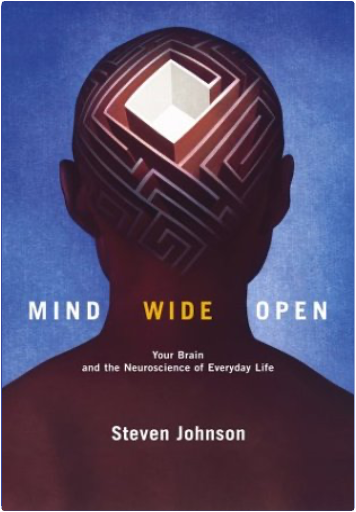 Mind Wide Open: Your Brain and the Neuroscience of Everyday LifeSteven Johnson
Mind Wide Open: Your Brain and the Neuroscience of Everyday LifeSteven Johnson 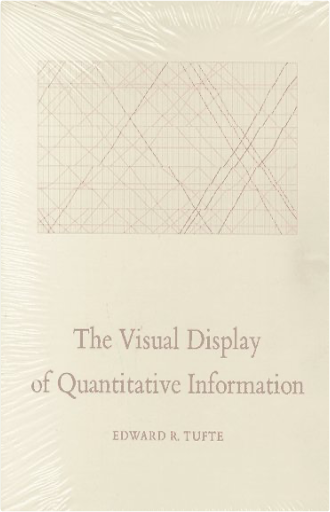 The Visual Display of Quantitative InformationEdward R. Tufte
The Visual Display of Quantitative InformationEdward R. Tufte  Envisioning InformationEdward R. Tufte
Envisioning InformationEdward R. Tufte 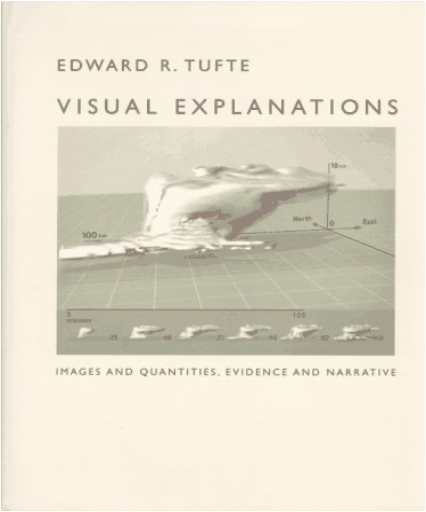 Visual Explanations: Images and Quantities, Evidence and NarrativeEdward R. Tufte
Visual Explanations: Images and Quantities, Evidence and NarrativeEdward R. Tufte  Beautiful EvidenceEdward R. Tufte
Beautiful EvidenceEdward R. Tufte  The Architecture Handbook: A Student Guide to Understanding BuildingsJennifer and Krisann Rehbein Masengarb
The Architecture Handbook: A Student Guide to Understanding BuildingsJennifer and Krisann Rehbein Masengarb  Why Architecture MattersPaul Goldberger
Why Architecture MattersPaul Goldberger  Made with Delicious Library
Made with Delicious Library